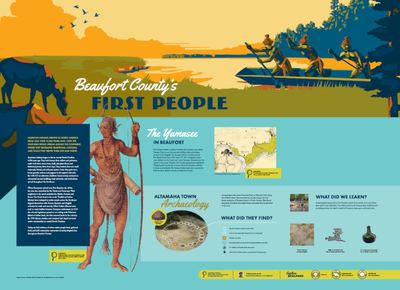
Beaufort County's First People
American Indians arrived in North America over 13,000 years ago. Over the centuries, people spread across the continent, where they developed traditions, customs, and tools that helped them live and thrive.
American Indians began to live in coastal South Carolina 4,500 years ago. They built homes from willow and palmetto, made tools from stone, bone, shell, and plant fibers, and fashioned pottery from local clays. They hunted deer and small mammals, fished, and collected oysters. Later they grew corn, beans, gourds, melons, and peppers in the region’s rich soils. By 1100 AD, an elaborate chiefdom-based society centered on mound building, trade networks, and horticulture spread throughout the Southeast.
When Europeans arrived near Port Royal in the 1500s, the area was controlled by the Orista and Escamaçu. Their neighbors to the north included the Edisto, Coosaw, and Sewee. The Guale lived to the south. Traditional Indian lifeways were reshaped as native people across the Southeast aligned themselves with French, Spanish, and English colonists for trade and security. Often Indian alliances were used to create buffers between European settlements. In 1712 the colonial legislature passed an act setting aside Polowana Island as Indian lands, the first reserved lands in the country. By 1750, disease, warfare, and conquest had wiped out most native communities in coastal South Carolina.
Today we find evidence of where native people lived, gathered food, and held community ceremonies in archaeological sites throughout our County.
-
Welcome!
-
Beaufort County's First People
-
The Yamasee Indians
-
Altamaha Town Archaeology
-
European Superpowers in Carolina
-
The Greatest and Fairest Haven
-
Beaufort's Golden Age
-
Patriots and Loyalists
-
Antebellum Beaufort – In Town (1782-1861)
-
Sea Island Cotton
-
Antebellum Beaufort – Plantations (1782-1861)
-
Battle of Port Royal (1861)
-
Beaufort and the Civil War (1861-1865)
-
The African American Experience (1861-1865)
-
Model of the New South: Postbellum Beaufort (1865-1893)
-
Robert Smalls -- The 'King' of Beaufort
-
The Great Depression – Riches to Rags
-
The Early 20th Century -- Here Comes the Marines!
-
The Early 20th Century -- Civil Rights
-
Rise of the Sunbelt -- Charles Fraser and the Fraser Effect
-
21st Century Beaufort -- The 'Chambers' Vision
-
Preserving Our History
-
The Greatest and Fairest Haven